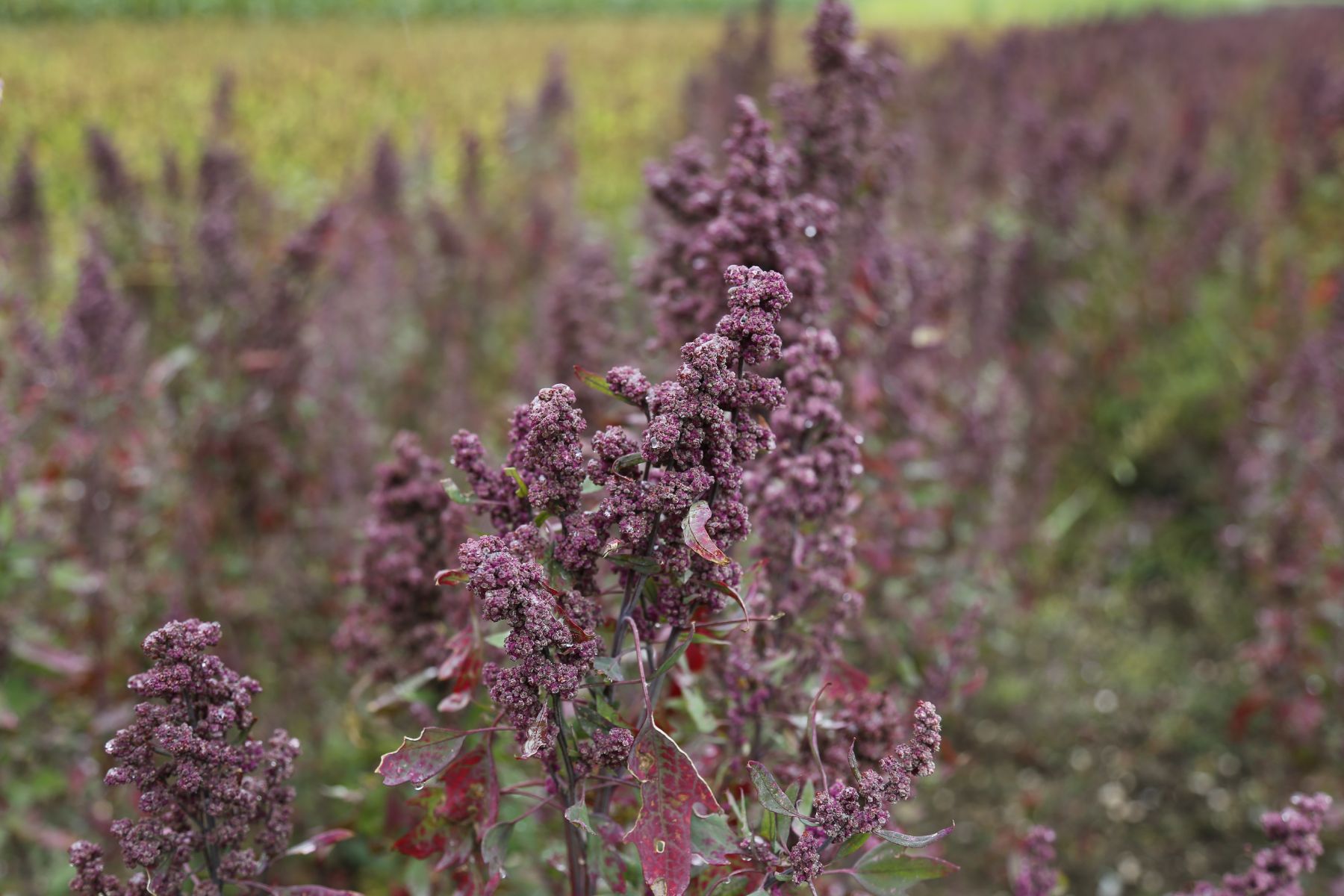
Allow us to introduce you to Emily Johnson, a true connoisseur in the realms of nutrition and vegetarian gastronomy. Emily’s journey is marked by years of dedicated involvement in the promotion and distribution of authentic Bolivian Royal Quinoa, which has bestowed her with an intricate understanding of its qualities and culinary versatility. Her recipes are a testament to her expertise, seamlessly blending health-conscious choices with delectable flavors. Embark on a flavorful adventure guided by Emily’s wealth of experience and her passion for the remarkable quinoa.
All about quinoa: The Nutritional Powerhouse
Quinoa is a highly nutritious grain originating from South America, particularly Bolivia and Peru. This ancient superfood is gluten-free and comes in various varieties, such as red, black, white, and a tricolor blend. Packed with protein, fiber, essential nutrients, and healthy fats, quinoa offers numerous health benefits. It can help manage blood sugar levels, aid in weight loss, and is versatile for incorporating into your meals. Whether used as a salad base or a rice or pasta substitute, cooking quinoa is simple and effortless. Learn more about quinoa and its advantages in the comprehensive article below.

What Is Quinoa?
Quinoa, pronounced as KEEN-wah, is a remarkable grain that has gained substantial popularity in recent years. It originates from South America, specifically Bolivia and Peru, where it was considered sacred by the Incas civilization. This ancient grain is highly valued for its exceptional nutritional profile and versatile culinary uses.
Quinoa is technically a seed, although it is commonly referred to as a grain due to its grain-like appearance and usage. What sets quinoa apart from other grains is its impressive nutrient composition, making it a nutrient powerhouse that offers a range of health benefits.
What makes quinoa even more appealing is its gluten-free nature. For individuals with gluten sensitivities or celiac disease, quinoa serves as an excellent substitute for gluten-containing grains like wheat, barley, and rye.
Today, quinoa is available in different varieties, including white, red, black, and even tricolor blends. Each variety has its distinct taste and texture, allowing for a diverse range of culinary creations.
The versatility and nutritional value of quinoa have earned it a place in the diets of health-conscious individuals and those following plant-based or gluten-free diets. So, let’s dive into the nutritious world of quinoa and explore its outstanding properties.
The Nutritional Power of Quinoa
Quinoa is not only a versatile grain but also a nutritional powerhouse that offers numerous health benefits. It is packed with protein, fiber, and essential nutrients, making it an excellent addition to a healthy diet.
Protein and Fiber Content in Quinoa
Quinoa stands out for its high protein content, making it an excellent plant-based protein source for vegetarians and vegans. It contains all the essential amino acids that the body needs but cannot produce on its own. Additionally, quinoa is rich in dietary fiber, which aids in digestion, promotes satiety, and helps maintain a healthy weight.
Essential Nutrients Found in Quinoa
Quinoa is a nutritional powerhouse, providing a wide range of essential nutrients necessary for overall health. It is abundant in minerals such as manganese, magnesium, phosphorus, copper, iron, and zinc, which are vital for various bodily functions. Quinoa also contains vitamins, including thiamine, riboflavin, and vitamin B6.
Quinoa and Its Gluten-Free Nature
One of the notable characteristics of quinoa is its gluten-free nature. This makes it an excellent choice for individuals with gluten sensitivities or celiac disease. Quinoa provides a safe alternative to gluten-containing grains, allowing those with dietary restrictions to still enjoy a diverse and nutritious diet.
Incorporating quinoa into your meals not only adds a flavorful touch but also boosts your nutrient intake. Whether used as a base for salads, a substitute for rice or pasta, or as an ingredient in various dishes, quinoa is a versatile grain that enhances both taste and nutritional value. Its many health benefits, including its impact on blood sugar levels and potential for weight loss, make it a valuable addition to a balanced diet.

Health Benefits of Quinoa
Quinoa offers numerous health benefits, making it a valuable addition to any diet. Let’s explore some of its key advantages:
Impact on Blood Sugar Levels
One of the significant benefits of quinoa is its impact on blood sugar levels. Due to its low glycemic index, quinoa provides a slower release of carbohydrates into the bloodstream, resulting in a more stable blood sugar level. This makes it an excellent option for individuals with diabetes type 2 who need to manage their blood sugar levels effectively.
Quinoa for Weight Loss
If you’re looking to shed some pounds or maintain a healthy weight, quinoa can be a valuable ally. Its high fiber and protein content contribute to a feeling of satiety, reducing overall calorie intake. Additionally, quinoa contains complex carbohydrates that are digested more slowly, keeping you feeling fuller for longer periods. Incorporating quinoa into your weight loss plan can help you achieve your goals in a healthy and sustainable way.
Quinoa as a Versatile Addition to Your Diet
Quinoa’s versatility makes it a valuable ingredient in various dishes. It can be used as a salad base, adding a nutritious boost to your greens. You can also incorporate it into soups or stews for a hearty and wholesome meal. As a rice or pasta substitute, quinoa offers a nutrient-rich alternative that is easy to prepare and delicious. With its mild, slightly nutty flavor, quinoa can be enjoyed in both savory and sweet recipes, making it a versatile addition to your diet.
Quinoa provides an array of health benefits, from stabilizing blood sugar levels to aiding in weight loss, and its versatility allows for numerous culinary possibilities. By incorporating quinoa into your meals, you can enjoy its nutritional power and enhance your overall well-being.
Incorporating Quinoa into Your Meals
Including quinoa in your meals is a wonderful way to enhance both the taste and nutritional value of your dishes. This versatile grain can be used in various ways, whether as a salad base, a rice or pasta substitute, or in other creative recipes.
Quinoa as a Salad Base
Quinoa makes an excellent base for vibrant and nourishing salads. Its fluffy texture and mild nutty flavor complement a wide range of ingredients. To create a delicious quinoa salad, start by cooking the quinoa according to the package instructions. Once cooked, let it cool before combining it with your favorite vegetables, herbs, and dressings. You can add diced tomatoes, cucumbers, bell peppers, avocado, or even fresh herbs like basil or cilantro. Drizzle with a tangy vinaigrette or a creamy dressing to bring all the flavors together. The result is a satisfying and nutritious salad that can be enjoyed as a side dish or a wholesome main course.
Quinoa as a Rice or Pasta Substitute
If you’re looking for a healthier alternative to rice or pasta, quinoa is an excellent choice. Its fluffy texture and subtle taste can easily replace these staples in your favorite recipes. Simply cook the quinoa as per the package instructions and use it in place of rice or pasta in your dishes. Whether you’re preparing stir-fries, pilafs, or even risottos, quinoa can lend a unique twist to your meals. Its protein and fiber content provide added nutritional value while keeping you satisfied.
Simple Ways to Cook and Use Quinoa
Preparing quinoa is a straightforward process that can be done in just a few simple steps. Start by rinsing the quinoa under cold water to remove any bitterness. Then, combine one part quinoa with two parts water or broth in a saucepan. Bring it to a boil, then reduce the heat and let it simmer for about 15-20 minutes, or until the liquid is absorbed and the quinoa becomes fluffy. Fluff it with a fork before serving.
Once your quinoa is cooked, the possibilities for usage are endless. You can use it as a filling for stuffed vegetables, as a topping for roasted vegetables, or even in breakfast dishes like porridge or granola. Get creative and experiment with different spices, herbs, and sauces to enhance the flavors even more.
By incorporating quinoa into your meals, you’ll not only be adding a nutritious grain but also introducing exciting flavors and textures to your culinary repertoire. Whether you choose to use it as a salad base, a rice or pasta substitute, or in other creative ways, quinoa is sure to elevate the overall taste and healthiness of your dishes.
FAQs about Quinoa
Quinoa has garnered considerable attention in recent years due to its nutritional value and versatility. Here are some frequently asked questions about quinoa and their answers:
Is Quinoa a Whole Grain?
Yes, quinoa is considered a whole grain. Unlike refined grains, which have been processed to remove the bran and germ, quinoa retains all its parts, making it a whole grain powerhouse. This means it contains all the essential nutrients found in the entire grain.
How Does Quinoa Compare to Other Grains?
Quinoa stands out from other grains due to its impressive nutrient profile. While most grains are primarily sources of carbohydrates, quinoa packs a protein punch. It is also a great source of fiber, healthy fats, and essential minerals, making it a more well-rounded choice compared to many other grains.
Can Quinoa Help Lower Cholesterol Levels?
Yes, including quinoa in your diet can potentially help lower cholesterol levels. Quinoa is rich in soluble fiber, which can bind to cholesterol in the digestive system, helping to remove it from the body. Consuming quinoa as part of a balanced diet that is low in saturated fats and cholesterol may contribute to maintaining healthy cholesterol levels.
Are There Any Potential Risks or Side Effects of Eating Quinoa?
While quinoa is generally safe for consumption, some individuals may experience allergic reactions or digestive issues. People with a known quinoa allergy should avoid consuming it. Additionally, quinoa contains small amounts of natural compounds called oxalates, which can contribute to kidney stone formation in susceptible individuals. However, most people can safely enjoy the benefits of quinoa without experiencing any adverse effects.
These frequently asked questions cover important aspects of quinoa, highlighting its role as a whole grain, its nutritional superiority compared to other grains, its potential in cholesterol management, and addressing any potential risks or side effects associated with its consumption.
